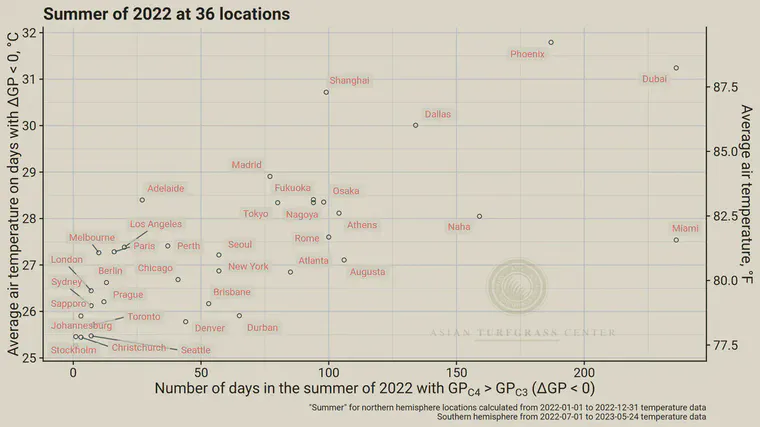Last summer at 36 locations
The delta GP (ΔGP) can be used as a statistic to show how difficult the summer was for cool-season grasses
For any day in the year, one can calculate the cool-season grass growth potential (GPC3) and the warm-season grass growth potential (GPC4). These growth potential functions take the average air temperature as the input and return a GP value on a scale of 0 to 1, or 0 to 100% if you prefer.
When the GPC3 is greater than the GPC4, I consider the temperatures to be more suitable for cool-season grass than for warm-season grass.1 When the GPC4 is greater than the GPC3, then temperatures seem more suitable for warm-season grass. One of the site-specific charts on the PACE Turf weather page is labeled “Growth Potential C3-C4” and that chart shows this difference, what I call delta GP (ΔGP), for each of the past five years.
I’ve applied this ΔGP calculation to temperature data from last summer for 36 locations around the world.

I actually included 40 locations initially, but Auckland, Cape Town, San Francisco, and Wellington did not make the chart, because there were 0 days with a negative ΔGP last summer at those locations.
In addition to showing the number of days at these locations with negative ΔGP during the summer of 2022, I also plotted the points at their average air temperature on those days. A few of these locations are unlikely to have cool-season grass. Or will have some cool-season grass, but only for winter overseeding.
Then there are places like Shanghai, Dallas, Madrid, Fukuoka—you can find a location near you on the chart—where there are plenty of creeping bentgrass greens, and where it is really hot in the summer.
The GPC4 is larger than GPC3 above an average air temperature of about 24.8 °C. You can see the GP equations here. ↩︎